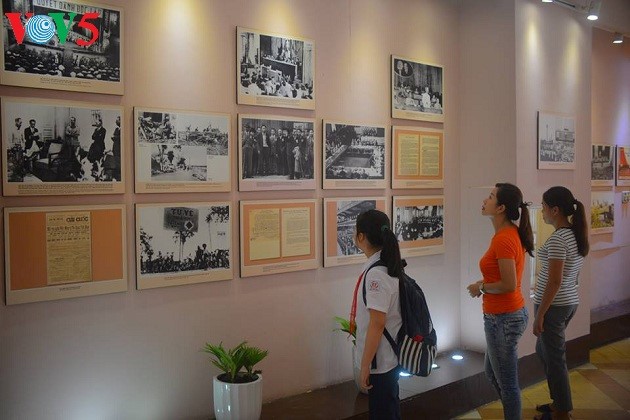(VOVWORLD) - In late August 1945, inside the house No 48 Hang Ngang street, Hanoi, President Ho Chi Minh drafted the Declaration of Independence giving birth to the Democratic Republic of Vietnam. Historical objects and evidence associated with President Ho Chi Minh remain intact.
 Photo: Duc Anh Photo: Duc Anh
|
In the 1940s, the building was the Phuc Loi Silk Shop, one of the main businesses of Hanoi owned by Mr. Trinh Van Bo and Mrs. Hoang Thi Ho. The 400-square meter-tubed house was built in the French architectural style. Its front is at 48 Hang Ngang street and its back is at 35 Hang Can street. President Ho Chi Minh worked and lived there from August 25 to September 2nd, 1945. In that building, President Ho Chi Minh and other Party Central Committee officials adopted the Declaration of Independence, the organization of National Day celebrations, and the line-up of the Provisional Government.
Nguyen Bich Hanh is from the Hanoi Landscape and Relic Management Committee: “The Party Central Committee chose this house to accommodate President Ho Chi Minh who moved from the Viet Bac resistance base to Hanoi because this house has two exits. It was always busy with customers but what the enemy would never think of is that the most dangerous place was the safest. It was arranged for President Ho Chi Minh was arranged to enter the house through gate at No 35 Hang Can street to get to the second floor. The first floor was the silk shop. On the second floor, there was a living and a dining room. Warehouses were on the third and fourth floors. In case of emergency, the President could exit through the roof to get to neighboring houses and to the street.”
 |
Over the many years, the architecture of the building has remained intact. The first floor became a memorial house in 1970. On major occasions including National Reunification Day April 30, August Revolution Day August 19, National Day September 2, and Hanoi Liberation Day October 10, thematic exhibits are displayed. Currently, an exhibition is held featuring 80 photos, documents and objects including a khaki costume that President Ho Chi Minh wore on September 2nd, 1945. The costume was made by the Trinh Phuc Loi tailor shop. On the second floor, there is a table where President Ho Chi Minh wrote the Declaration of Independence and a meeting of the President and other Party Central Committee members. Ms Hanh again: ‘This is a table and chairs used by President Ho Chi Minh. He often sat here, and sometimes, he went to the dining room to work. The host family didn’t know that the old man in the dark brown costume was President Ho Chi Minh. They only recognized the President when he read the Declaration of Independence in Ba Dinh Square on September 2, 1945.”
The historical house has drawn a lot of visitors. Thomas Bayer of the UK said that he was surprised to learn that Vietnam’s Declaration of Independence was written in such a small room of 20 square meters. President Ho Chi Minh’s living and working place was simple with a small cabinet, a bed, and a set of chairs and table.
Located on the second floor was the living room where President Ho Chi Minh received ethnic minority people from Viet Bac. At the end of the corridor was the meeting room of President Ho Chi Minh and his aids General Vo Nguyen Giap, Nguyen Luong Bang, Truong Chinh, Tran Dang Ninh, and Khuat Duy Tien. Ms Hanh said: “Before President Ho Chi Minh read the Declaration of Independence, it was in this house where he received on August 26, 1945 a special guest, Major Colonel Archimedes L.A Patti, Commander of the OSS, the US Office of Strategic Service. He was the first foreigner to have a look at the Declaration of Independence before it was announced. President Ho Chi Minh invited him to attend the celebration of National Day of the Democratic Republic of Vietnam on September 2, 1945.”
Nguyen Thi Chi is a visitor from Hoa Binh province: “Visiting the house, I better understand the important role of the people. Mr. Trinh Van Bo’s family’s enthusiastic and wholehearted support for the revolution contributed to the success of Vietnam’s national liberation struggle. Young people like me are more aware of the need to study harder to contribute to national development.”
In 1979, the house No 48 Hang Ngang street was recognized as a National Historical Relic.
Le Phuong